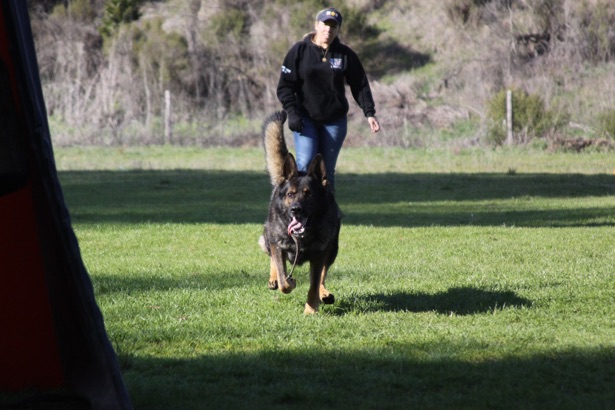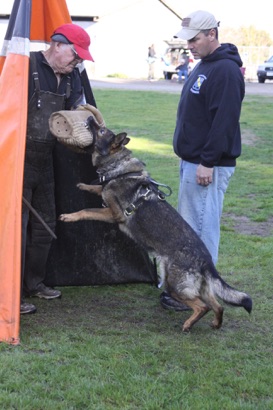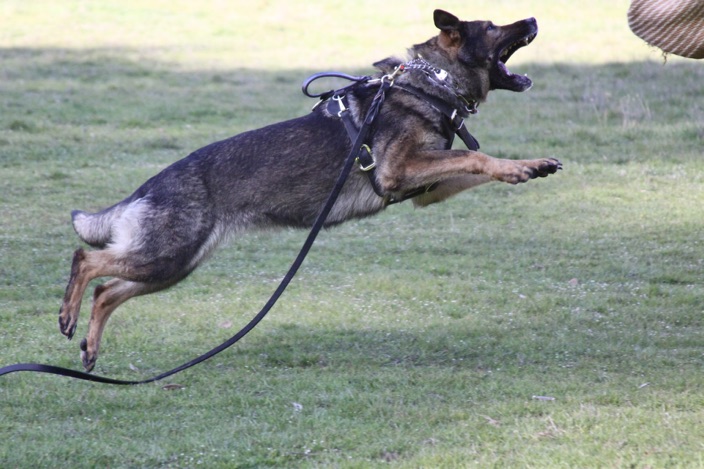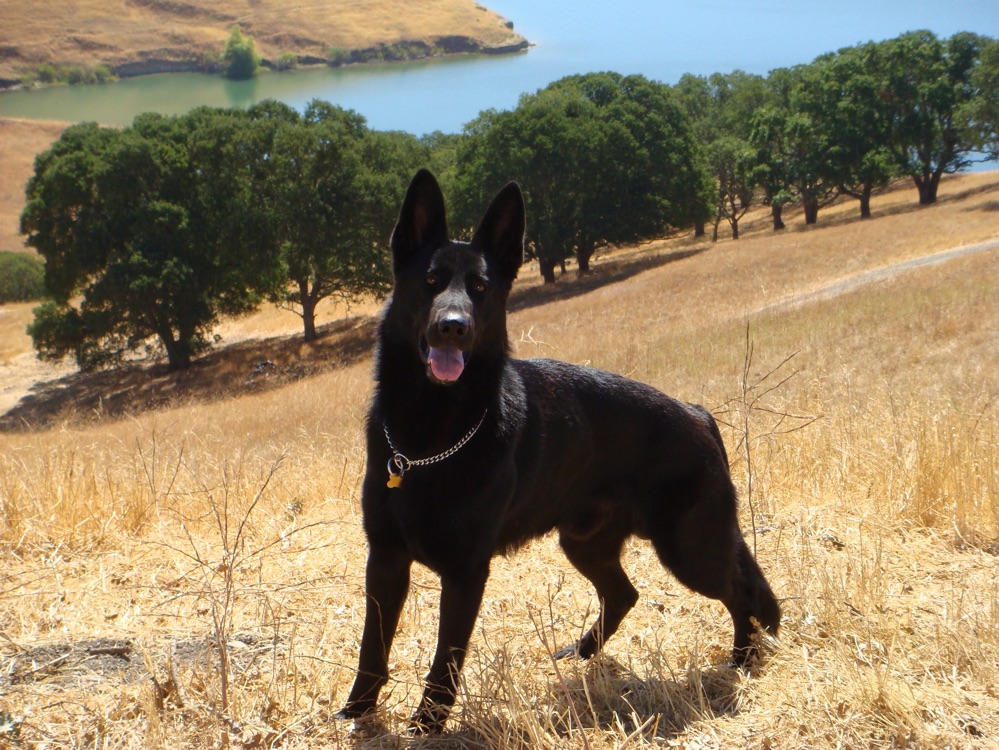Breed Info



KKL 1A and KKL 2A : KKL= Koerklasse. Before a dog can be bred in Germany it must achieve a SchH title, IPO title or equivalent, and then it must also be evaluated by an official of the German Shepherd Club of Germany (Schaeferhund Verin) called a Koermeister to further test and evaluate the dog's temperament and structure. Every part of the dog is described in a report called a Koerreport. Dogs that are considered to be prime quality breeding prospects will be graded KKL1, dogs considered acceptable for breeding, but with some warnings of what to watch out for, such as being oversized, etc.will be graded KKL2. Dogs considered "not suitable for breeding" will not earn a KKL rating, and they can not be bred in Germany. The "A" means the dog has passed it's hip certification for Hip Dysplasia in Germany.
SchH and IPO (1, 2 &3): Schutzhund: Schutzhund is a test of the dog's trainability and talents in Tracking (following a person's trail similar to Search work), Advanced Obedience (includes working under gunfire. Dogs that are afraid of gunfire are also afraid of thunder and lightening...a real problem. If you've ever had a dog that is afraid of loud noises, you'll understand why it is important), and the dog is tested for it's Protection abilities. A Schutzhund dog must work off leash in a crowd of people with out endangering any one. They are the 'cream of the crop' when it comes to trained dogs! IPO is the international test that is identical to Schutzhund, so the titles have the same meaning.
"A" Stamp: The "A" means the dog has passed it's hip certification for Hip Dysplasia in Germany.
OFA: Orthopedic Foundation for Animals: A part of Columbia University which receives, evaluates, and certifies Hip x-rays for dogs in the USA. An OFA hip certified dog is listed as "having no evidence of hip dysplasia". There are different levels of certification. The grading takes several factors into consideration which include the structure of the hip joint, the clarity and quality of the hip x-ray itself, and the positioning of the dog's hips on the x-ray. All levels of certification (fair, good or excellent) are free of hip dysplasia and are suitable for breeding.
RATING AND TITLES INFO
Health Disorders known in German Shepherds - Common and Uncommon
Sub-Aortic Stenosis (SAS)
This congenital heart condition has been found in German Shepherd Dogs, although major efforts are underway to eliminate (severely reduce) this condition. Ranging from minor heart murmurs to fatal, this condition covers a wide array of symptoms.
Progressive Retinal Atrophy (PRA)
Progressive Retinal Atrophy (PRA) and Central Progressive Retinal Atrophy (CPRA) are among the most common eye problems in German Shepherd Dogs. These conditions usually begin to display symptoms at about 2 years of age. They are progressive in their degeneration. Both conditions are hereditary. Both parents should have current CERF certification documents. CERF certifications last one year.
Cardiomyopathy
This is a general term meaning "disease of the heart muscle". There are various types of cardiomyopathy, one being "Dilated Cardiomyopathy" (DCM), opposed to "Hypertrophic" Cardiomyopathy" (where the heart walls thicken instead of becoming thin). Cardiomyopathy is a serious problem in many breeds.
Diabetes Mellitus
As with diabetes in humans, diabetes mellitus in dogs is primarily attributed to insufficient insulin production by the pancreas. Diabetes impacts the entire animal. With early diagnosis, treatment, and controlled diet the animal can live a long healthy life.
Pancreatitis
Pancreatitis is the inflammation of the pancreas. This condition can occur once in dogs life, or be the first of many (chronic) occurrences. One of the main contributors to pancreatic flair ups is dietary (dog fed a particularly high fat meal), which the digestive system is not accustomed to.
Hip Dysplasia (HD)
Hip Dysplasia is the result of the malformation of the hip joint(s). This condition is a common difficulty in most of the large dog breeds. This condition is both genetic and environmentally influenced.
Both parents of any German Shepherd Dog puppy you are considering purchasing should be certified by OFA or a comparable rating system to be free of Hip Dysplasia.
Elbow Dysplasia
Elbow Dysplasia is a developmental disorder of the bones associated with the elbow joint. This disease is generally accepted as genetic in nature, and can occur in multiple levels of severity.
As with Hip Dysplasia, both parents should be certified as free of Elbow Dysplasia prior to breeding.
Intervertebral Disc Disease
German Shepherd Dogs are prone to degenerative disc disease although some bloodlines appear to have a higher incidence of this problem than others. Dogs with spinal problems should never be used for breeding.
Osteochondrosis Dissecans (OCD)
Osteochondrosis Dissecans is a disorder of bone formation resulting from a defect in the transition of cartilage into bone during the growth process. This condition appears to be genetic in nature, being far more common in some bloodlines than others. Similar to hip dysplasia, environmental factors can be contributory.
Panosteitis
Occasionally referred to as "wandering lameness", this is more of a syndrome than a disease. Similar to growing pains in human adolescents. Commonly referred to as Pano, this condition presents itself as spontaneous lameness, affecting dogs between the ages of 5 to 18 months. Primarily it affects males but can be present in females and often causes pain in one leg and then another from day to day.
for more info- http://www.royalair.org/pano.html
Epilepsy
Epilepsy is a hereditary seizure disorder. Although it can not be cured, it can be managed with medication. The dog with epilepsy can live a fairly normal life, but cannot be placed in the stressful situation of showing, and should not be bred.
Von Willebrand's Disease (vWD)
von Willebrand's disease is a hereditary bleeding disorder. It impacts the dog's ability to clot blood (similar to hemophilia). This disorder is found in both males and females.
Hemophilia A
This recessive genetic disorder is usually found in males, with females being the carriers. Commonly referred to as the "bleeders disease", hemophilia is due to insufficient levels of the factor VIII blood clotting factor. Usually accompanied by hematomas (pockets of blood under the skin), this condition is present from birth.
Bilateral Cataracts
Cataracts in dogs, much like in humans, can be identified as opaque spots on the lens of the eye. These spots may cause total or partial loss of vision. Some cataracts are hereditary while others are not. In some cases surgery is appropriate.
Pannus
Pannus cataract (chronic superficial keratitis): Chronic immune mediated keratoconjunctivitis sicca (CIKS) is the newer name for pannus. It is a serious inflammation of the cornea and is potentially blinding.
Cherry Eye
The tear gland that normally occupies the base of the third eyelid occasionally becomes enlarged, and will protrude beyond the leading edge of the third eyelid. This protrusion will appear as a round, red mass (cherry eye).
Cleft Palate
Occasionally pups can be born with an opening (cleft) in the roof of the mouth. Most often in German Shepherd Dogs this condition is genetic in nature. In minor cases the cleft can be surgically corrected, although a pup that has had cleft surgery should never be bred.
Gastric Torsion - or Bloat (Gastric dilatation volvulus GDV): This condition is caused by a twisting of the stomach and thus trapping the stomach contents and gases resulting in a rapid swelling of the abdomen accompanied by pain and eventual death if untreated. It is a emergency with immediate veterinarian action required. This is a predicament most common in large deep chested breeds and common in German Shepherds. It can be prevented with a surgery called a gastropexi- stapling of the stomach and inhibiting the stomach from twisting. We encourage anyone who has their dog in for any abdominal surgery to include this in their procedure.
Hot Spots
Pyotraumatic dermatitis ("hot spots"): is one of two types of bacterial infections confined to the surface of the skin (the other being "skin fold dermatitis"). It is caused by allergies, parasites and poor grooming.
Skin allergies: Allergies in pets, are one of the most common causes of skin conditions. Allergies can be difficult to control and are chronic in nature. There are 3 main types of allergies in relation to skin conditions. It is possible for a pet to have a combination of all 3 allergy types: 1. Food Allergy; 2. Flea Allergy Dermatitis (FAD); 3. Atopy, or Allergic Inhaled Dermatitis.
Degenerative Myelopathy
Degenerative myelopathy is a progressive disease of the spinal cord in older dogs. The disease has an insidious onset typically between 5 and older in German Shepherd Dogs. It begins with a loss of coordination (ataxia) in the hind limbs. The affected dog will wobble when walking, knuckle over or drag the feet. This can first occur in one hind limb and then affect the other. As the disease progresses, the limbs become weak and the dog begins to buckle and has difficulty standing. The weakness gets progressively worse until the dog is unable to walk. The clinical course can range from 6 months to 1 year before dogs become paraplegic. If signs progress for a longer period of time, loss of urinary and fecal continence may occur and eventually weakness will develop in the front limbs. DM is not a painful disease.
Degenerative myelopathy begins with the spinal cord in the thoracic (chest) region. If we look under the microscope at that area of the cord from a dog that has died from DM, we see degeneration of the white matter of the spinal cord. The white matter contains fibers that transmit movement commands from the brain to the limbs and sensory information from the limbs to the brain.
This degeneration consists of both demyelination (stripping away the insulation of these fibers) and axonal loss (loss of the actual fibers), and interferes with the communication between the brain and limbs. Recent research has identified a mutation in a gene that confers a greatly increased risk of developing the disease.
Any disease affecting the dog’s spinal cord may produce loss of coordination and weakness. Testing to rule out other disease is imperative. The most common cause of hind limb weakness is herniated intervertebral disks. The disks are shock absorbers between the vertebrae in the back. When herniated, they can cause pressure on the spinal cord and weakness or paralysis. Short-legged, long back dogs are more prone to slipped disks. A herniated disk can often be detected with X-rays of the spine, CT scan or MRI. Tumors, cysts, infections, injuries and stroke may cause similar symptoms and should be ruled out diagnostically. If necessary, your veterinarian can refer you to a board certified neurologist who can aid in diagnosing degenerative myelopathy.
There is no known treatment for DM.
The currently used genetic test for DM was made available in 2008. Recently there has been evidence to substantiate the existence of more than one type of DM. The test that is available is only known to test for the most common form. It is unknown how many types or variations of DM there are and research is ongoing.
TESTING FOR DM and what the results mean- there are 4 possible test results- taken from the Orthopedic Foundation For Animals Website......
Normal (N/N)This dog is homozygous N/N for the mutation that is the most common cause of DM, with two normal copies of the gene. Among the hundreds of dogs studied so far at the University of Missouri, only two dogs with test results of N/N (Normal) have been confirmed to have DM. The N/N (Normal) dog can only transmit the normal counterpart of the common mutation to its offspring, and it is unlikely that this dog or its offspring will ever develop DM.
Carrier (A/N)This dog is heterozygous A/N, with one mutated copy of the gene and one normal copy of the gene, and is classified as a carrier. Carriers are far less likely to develop DM, but we have confirmed DM in a few carrier dogs. They may be used carefully in breeding programs to keep their good qualities while reducing risk of DM in future generations.
At-Risk (A/A) This dog is homozygous A/A, with two mutated copies of the gene, and is at risk for developing Degenerative Myelopathy (DM). Although almost all dogs in the research study with confirmed DM have had A/A DNA test results, recent evidence suggest that there are other causes of DM in some breeds. In addition, not all dogs testing as A/A have shown clinical signs of DM. DM is typically a late onset disease, and dogs testing as A/A that are clinically normal may still begin to show signs of the disease as they age. Some dogs testing A/A did not begin to show clinical signs of DM until they were 15 years of age. Research is ongoing to estimate what percentage of dogs testing as A/A will develop DM within their lifespan. At this point, the mutation can only be interpreted as being at risk of developing DM within the animal's life. For dogs showing clinical signs with a presumptive diagnosis of DM, affected (A/A) test results can be used as an additional tool to aid in the diagnosis of DM. Dogs testing At-Risk (A/A) can only pass the mutated gene on to their offspring.
Equivocal An Equivocal test result indicates that the test results were inconclusive. This is typically the result of poor sample collection. When the test yields an equivocal result, a second punch will be taken from the FTA card and the test rerun. If the second test is still equivocal, the owner will be contacted and asked to submit a new sample.
COAT
a) The medium smooth coated German Shepherd Dog
The outer coat should be as thick as possible. The individual hairs are straight, coarse and lying flat against the body. The coat is short on the head inclusive of the ears, the front of the legs, the feet and the toes but longer and thicker on the neck. The hair grows longer on the back of the fore- and hind legs as far down as the pastern and the hock joint, forming moderate breeching on the thighs. the length of the hair varies, and due to these differences in length, there are many intermediate forms. A too short or molelike coat is faulty.
b) The long smooth coated German Shepherd Dog
The individual hairs are longer, not always straight and above all not lying close to the body. The coat is considerably longer inside and behind the ears, on the back of the forearm and usually in the loin area. now and then there will be tufts in the ears and feathering from elbow to pastern. The breeching along the thigh is long and thick. The tail is bushy with slight feathering underneath. the long-smooth-coat is not as weatherproof as the medium-smooth-coat and is therefore undesirable; however, provided there is sufficient undercoat, it may be passed for breeding, as long as the breed regulations of the country allow it.
With the long smooth coated German Shepherd Dog, a narrow chest and narrow overstretched muzzle are frequently found.
c) The long coated German Shepherd Dog
The coat is considerably longer than that of the long-smooth-coat. It is generally very soft and forms a parting along the back. The undercoat will be found in the region of the loins or will not be present at all. The long coat is greatly diminished in weatherproofing and utility and therefore throughout the history of the breed the long coated GSD has been considered undesirable.
In 2011, the SV allowed the long coated GSD to compete in a class of their own for the first time in the history of the breed. The LCGSD can now achieve breed survey scores and confomation ratings.
SchHA - Novice Schutzhund obedience and protection
Bh - Basic companion dog - traffic sureness
WH - Watch Dog
AD - Endurance
SchH1 - Novice Schutzhund qualification in tracking, obedience, and protection
SchH2 - Intermediate Schutzhund qualification in tracking, obedience, and protection
SchH3 - Masters level of Schutzhund tracking, obedience, and protection.
FH1 - Advanced tracking
FH2 - Superior tracking qualification.
IPO1 - International Novice Schutzhund trial qualification.
IPO2 - International Intermediate Schutzhund.
IPO3 - International Masters level Schutzhund.
BpDH1 2 - Railroad Police Dog
BIH - Blind Leader Dog
DH - Service Dog
DPH - Service Police Dog
HGH - Herding Dog
LwH - Avalanche Dog
PFP1 PFP2 - Police Tracking Dog
PH - Police Dog (obtained through the Danish Politihundeforeningen. Open to civilians)
PSP1, 2 3 - Police Guard Dog
RtH - Rescue Dog
ZFH - Customs Tracking Dog
ZH1, 2 3 - Customs Dog
Africa - IWT 1, 2,
Austria - SchH1, 2 3 and FHA 1, 2, 3
Belgium - Cereco1, IWR1, 2 3 equivalent to IPO1, 2 3
Czech Republic - ZVV1, 2 3 equivalent to SchH1, 2 3
Denmark - BHP1, 2 3 equivalent to SchH1, 2 3 and SPH equivalent to FH
England - PD (Police Dog)
Finland - SK1 equivalent to IPO1
Holland - VH1, 2 3 equivalent to SchH1, 2 3 and SPH equivalent to FH
Hungary - SZL1, 2 3 also ZVV1, 2 3 equivalent to SchH1, 2 3
Italy - Brevetto 1, 2 3 equivalent to SchH1, 2 3
Poland - ZVV1, 2 3 equivalent to SchH1, 2 3
Switzerland - SchH, SchHB, SchHC; CHD1 equivalent to SchH1
Yugoslavia - CAB1, 2 3 equivalent to SchH1, 2 3
Breed Survey Info

